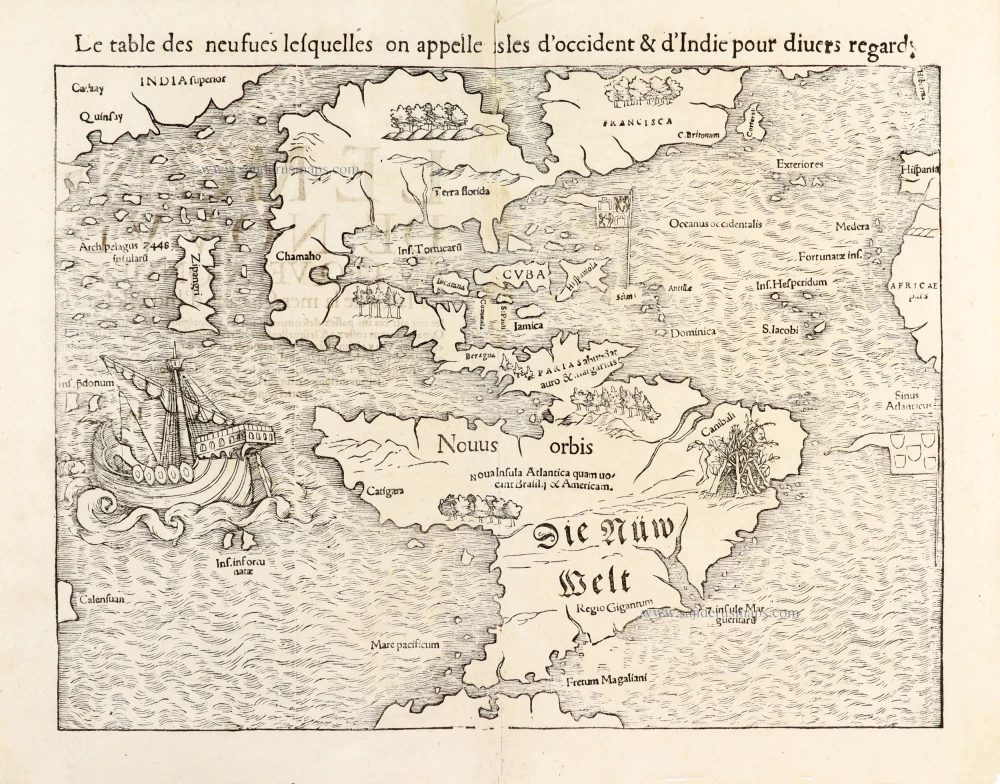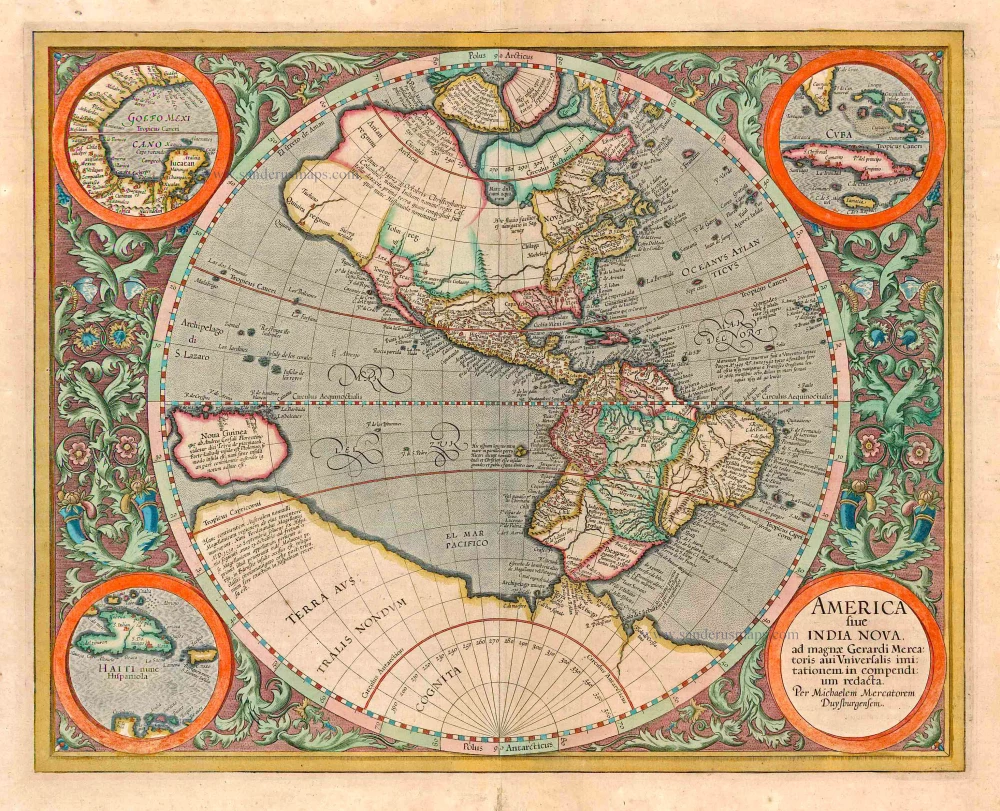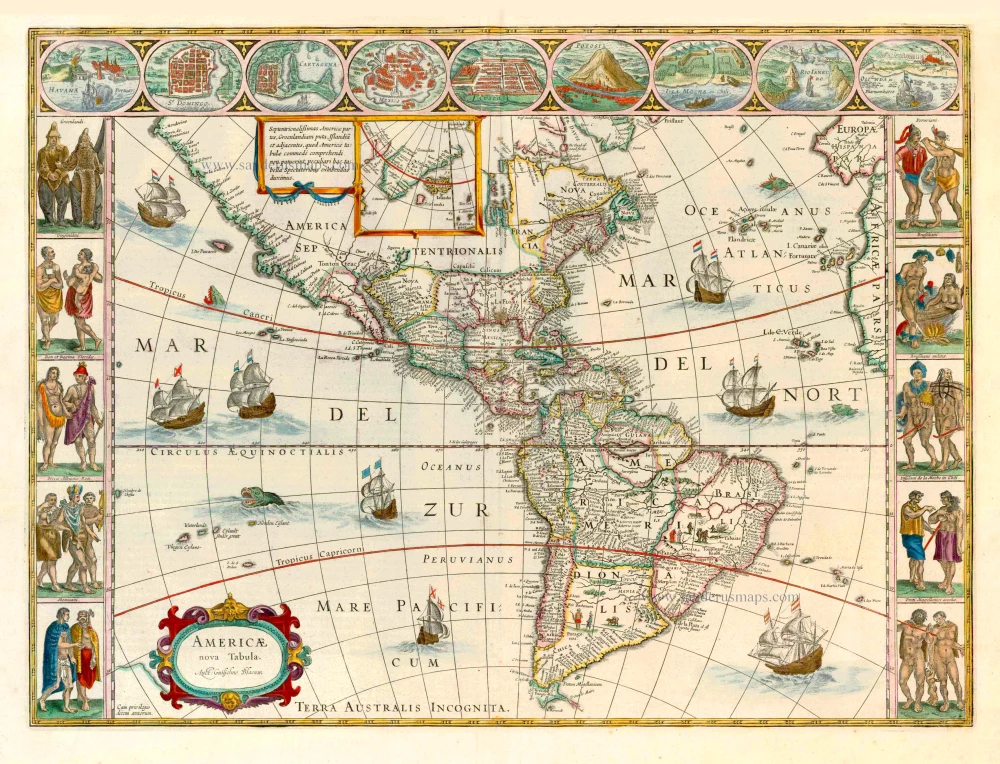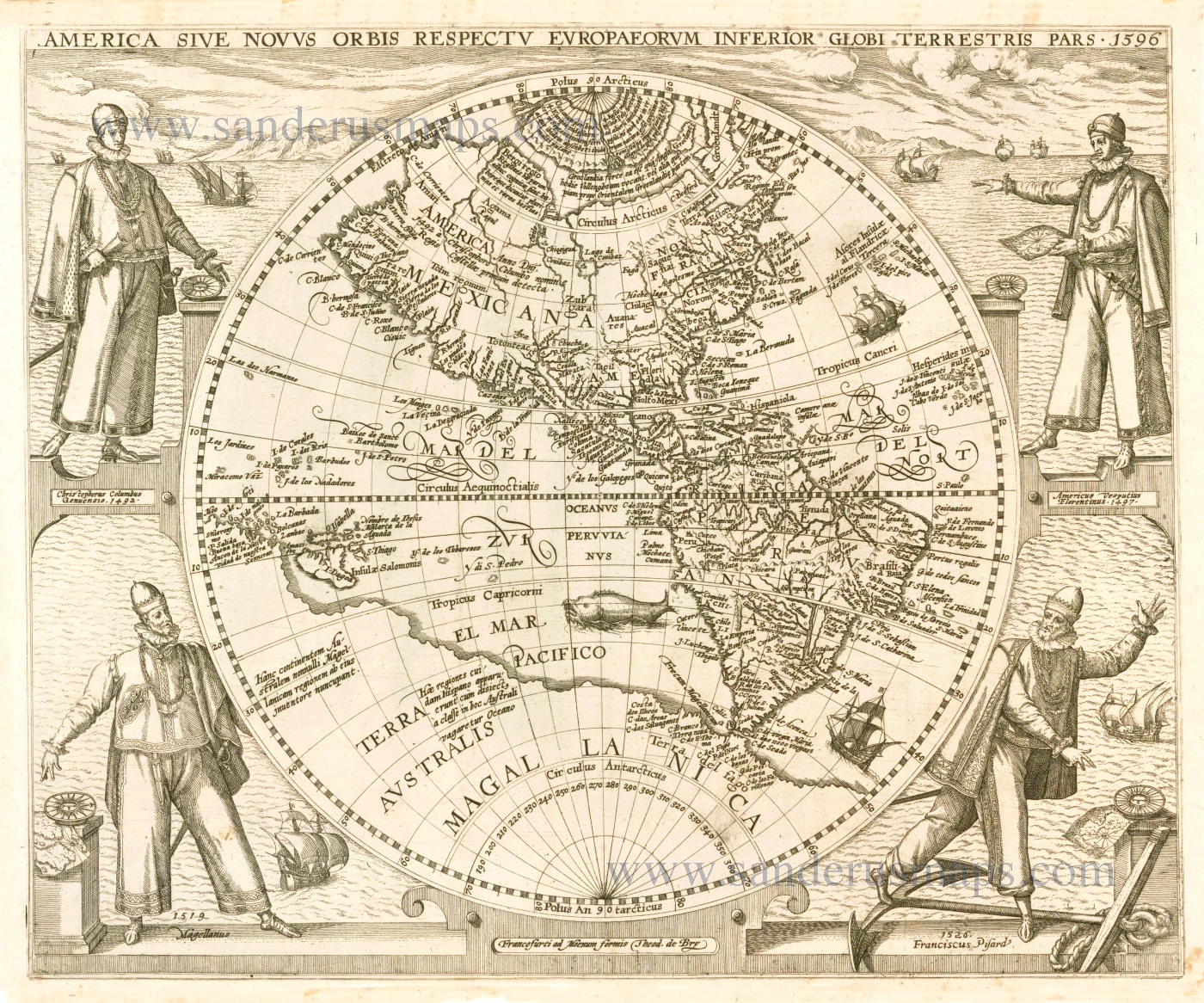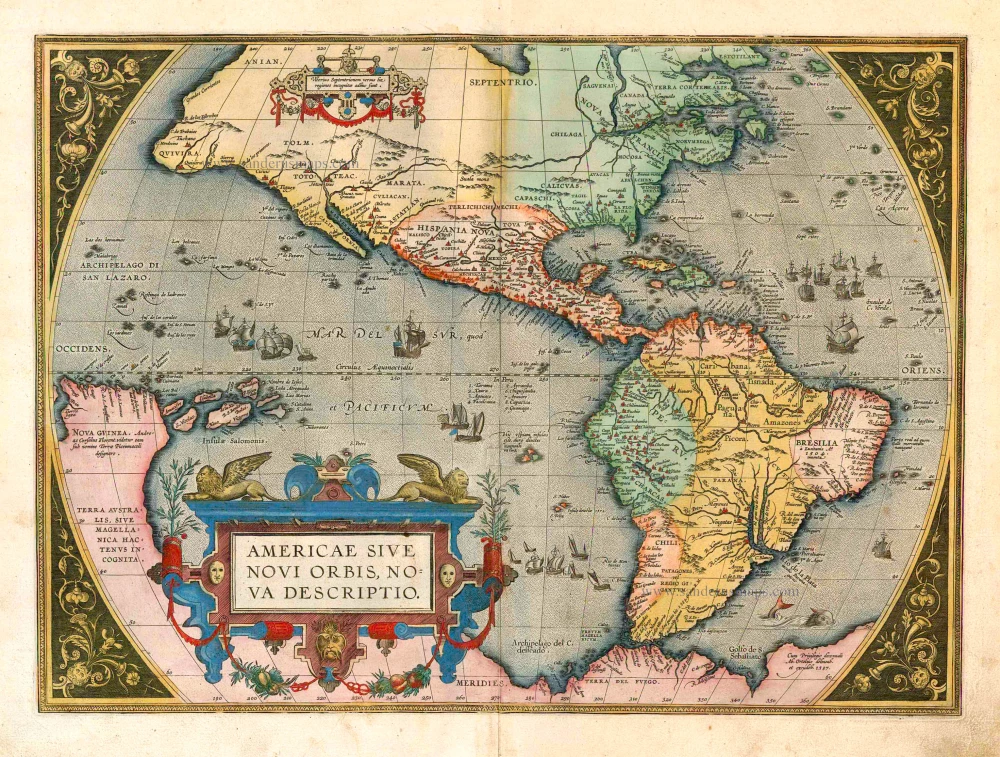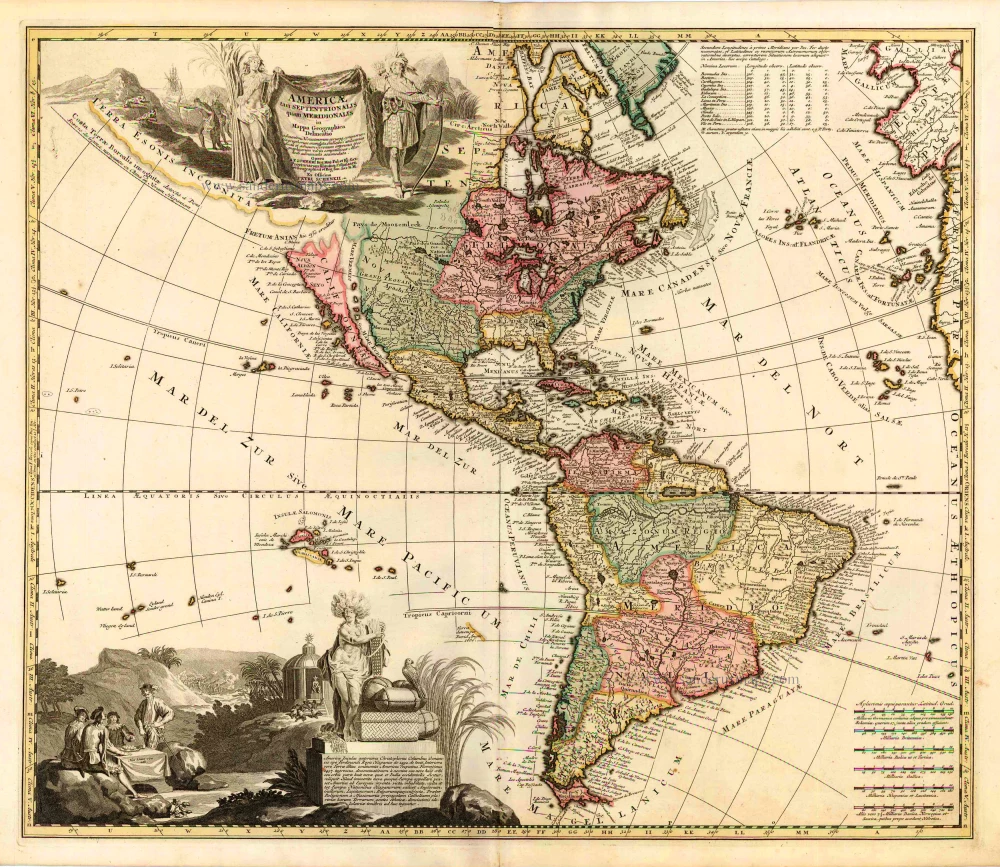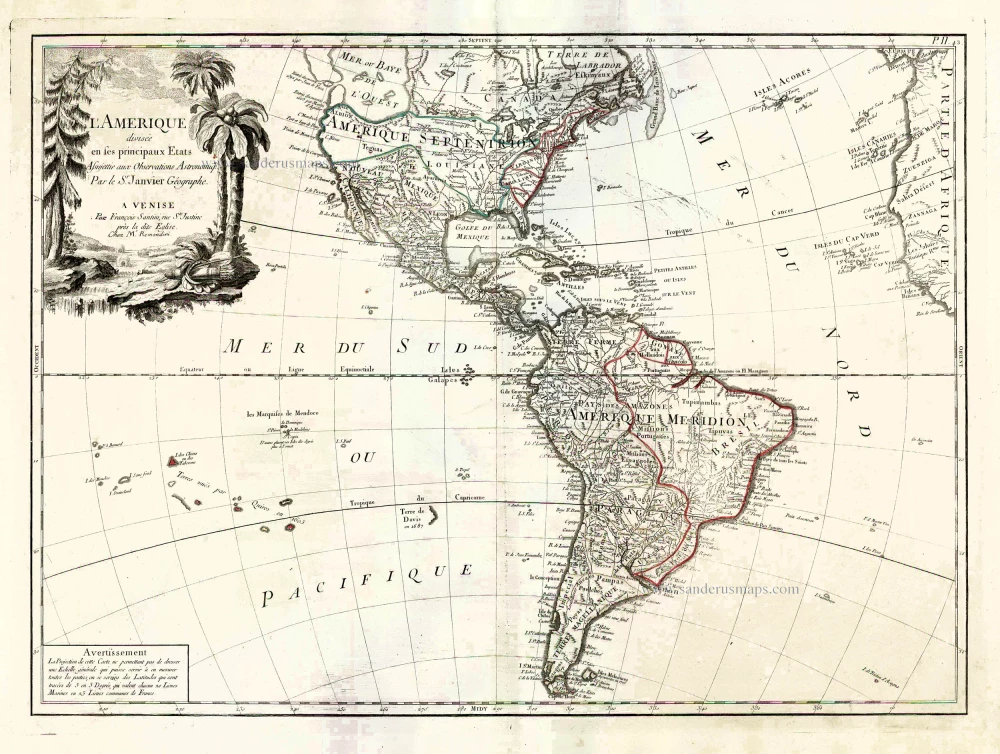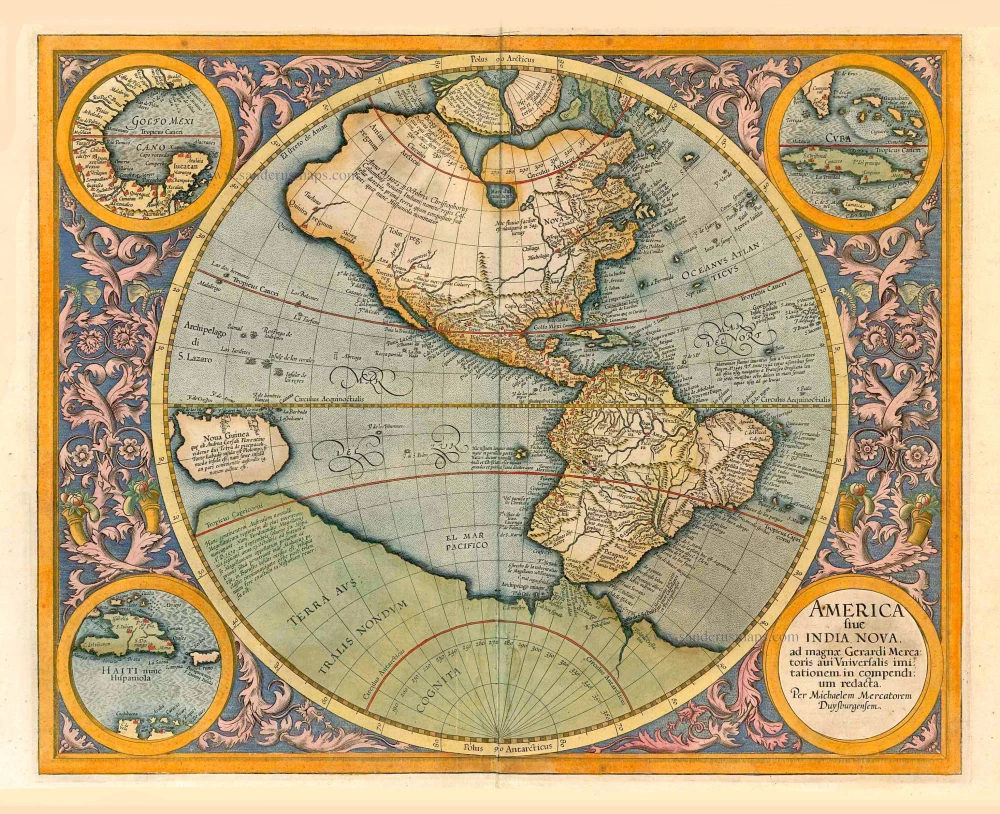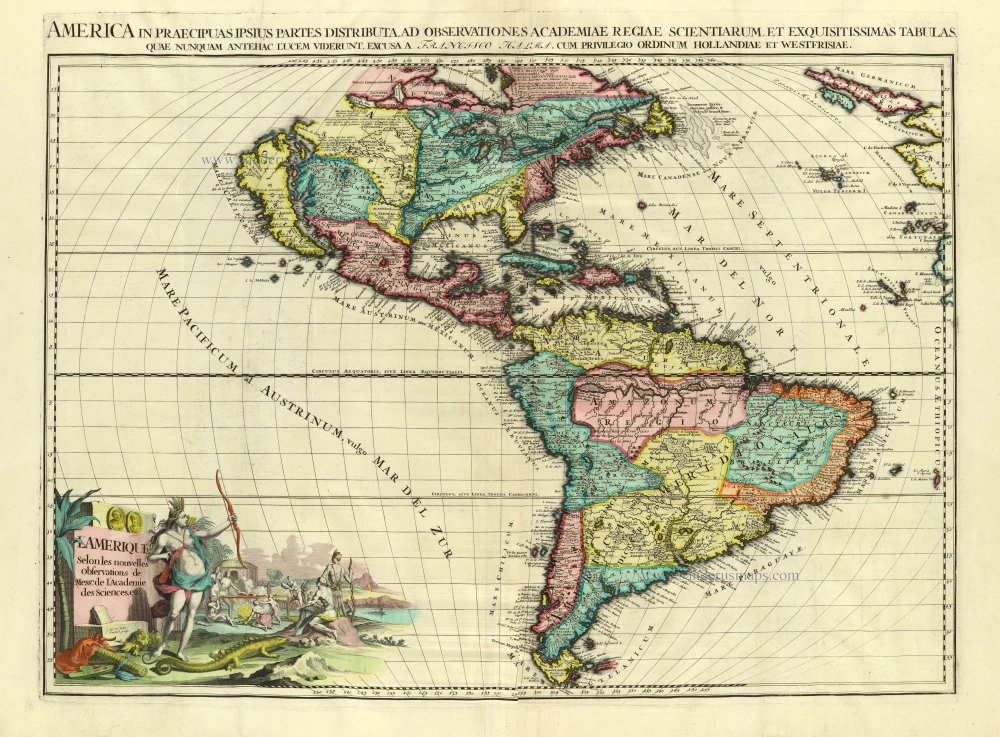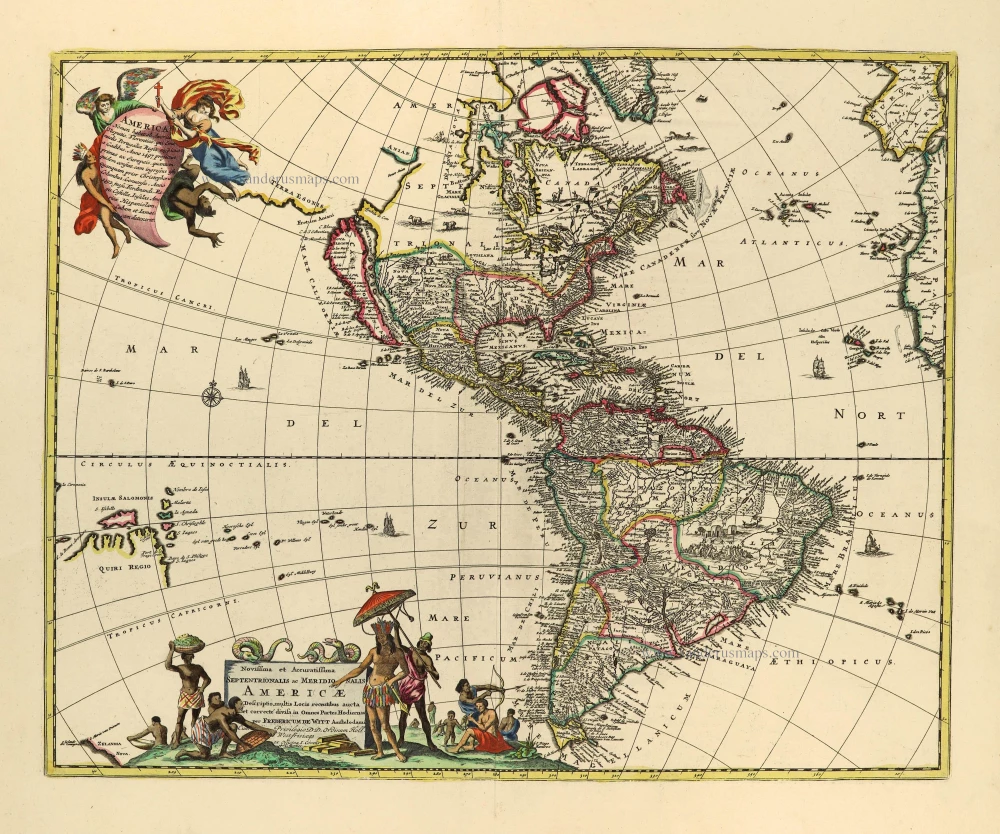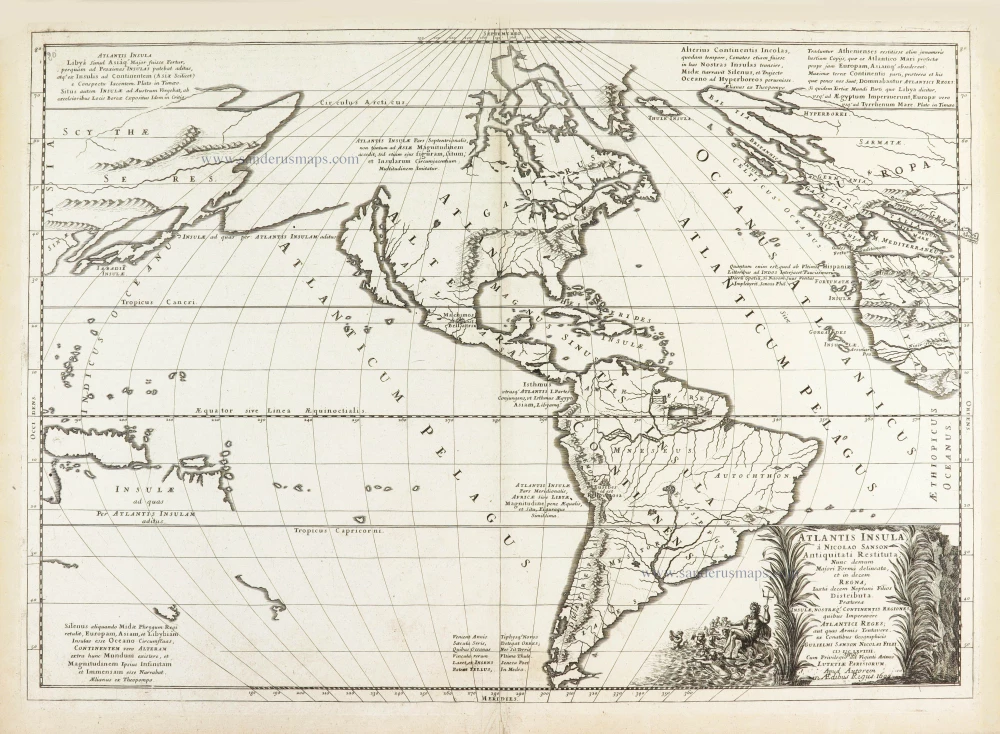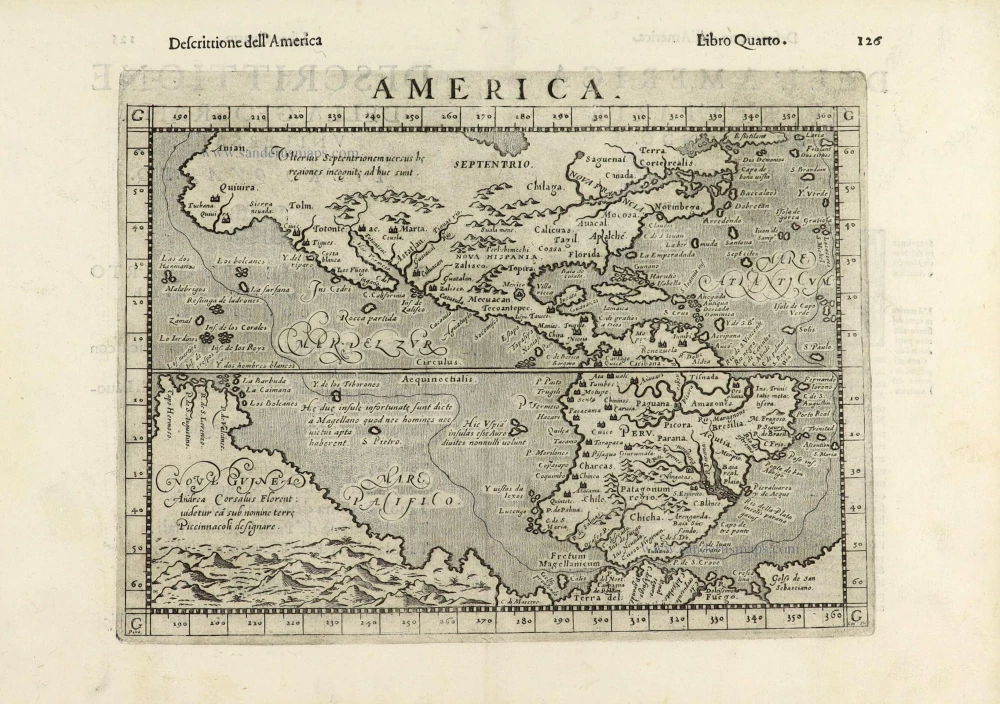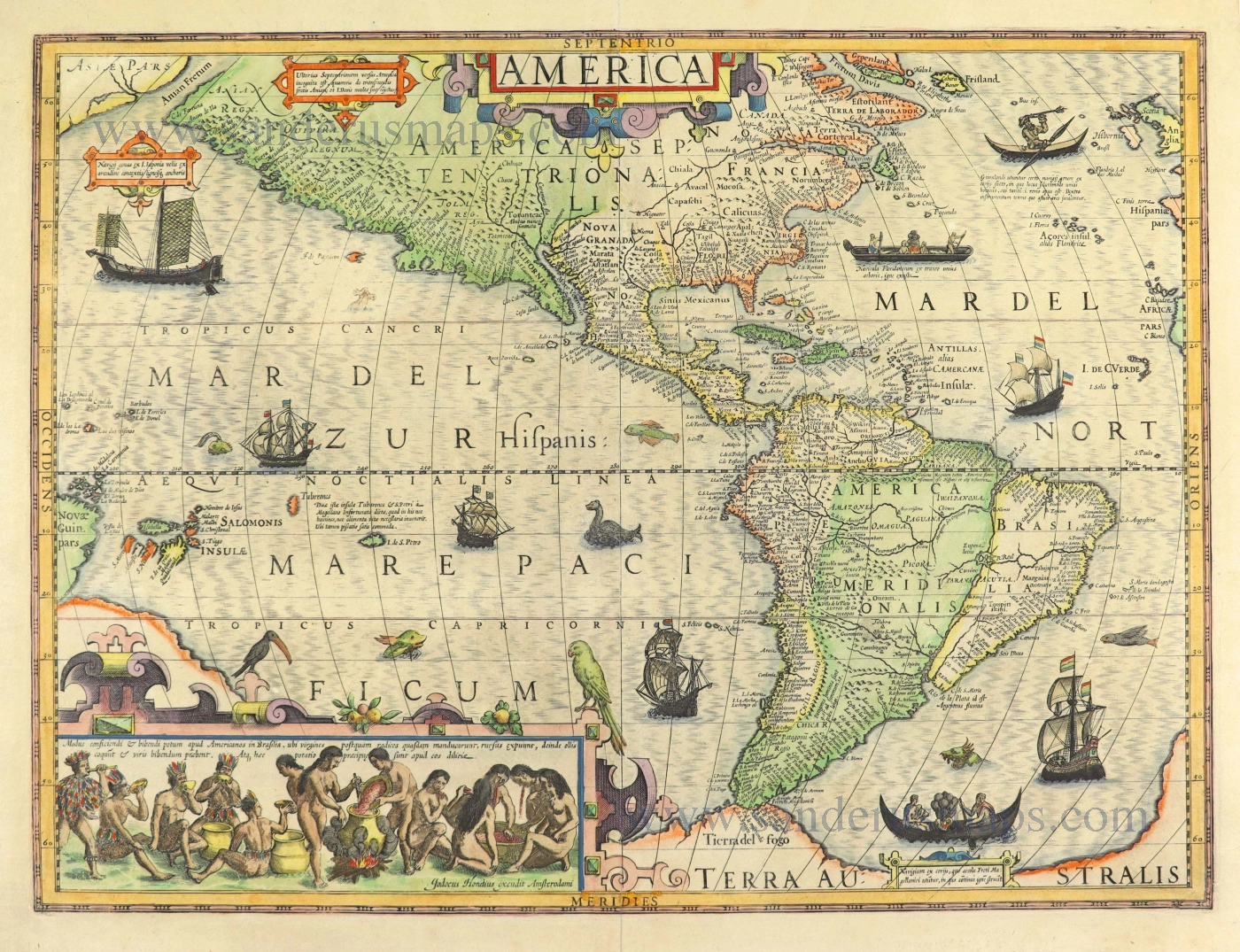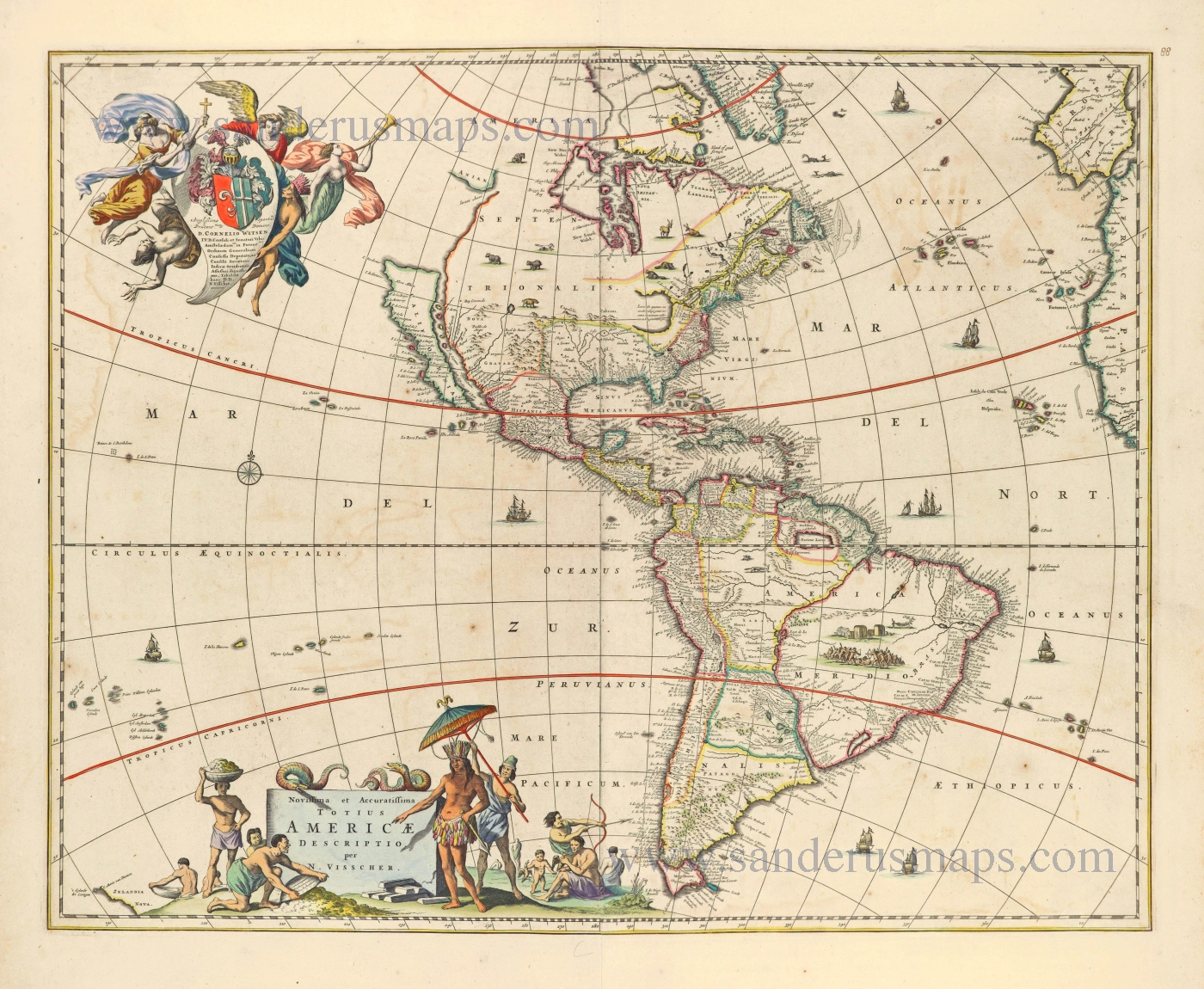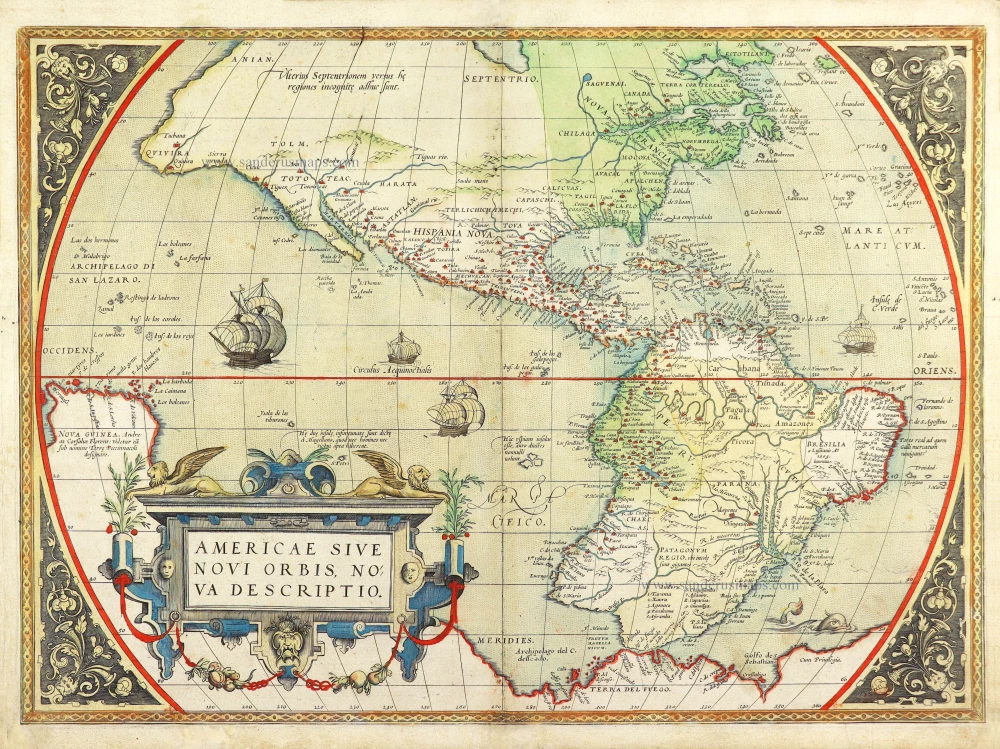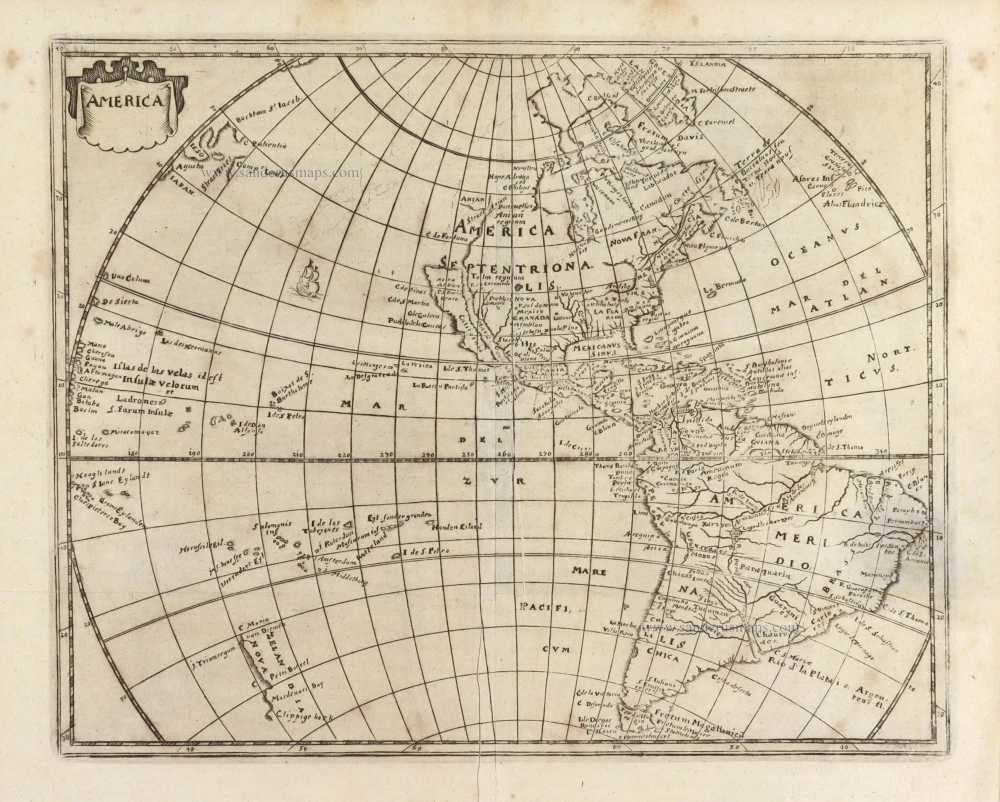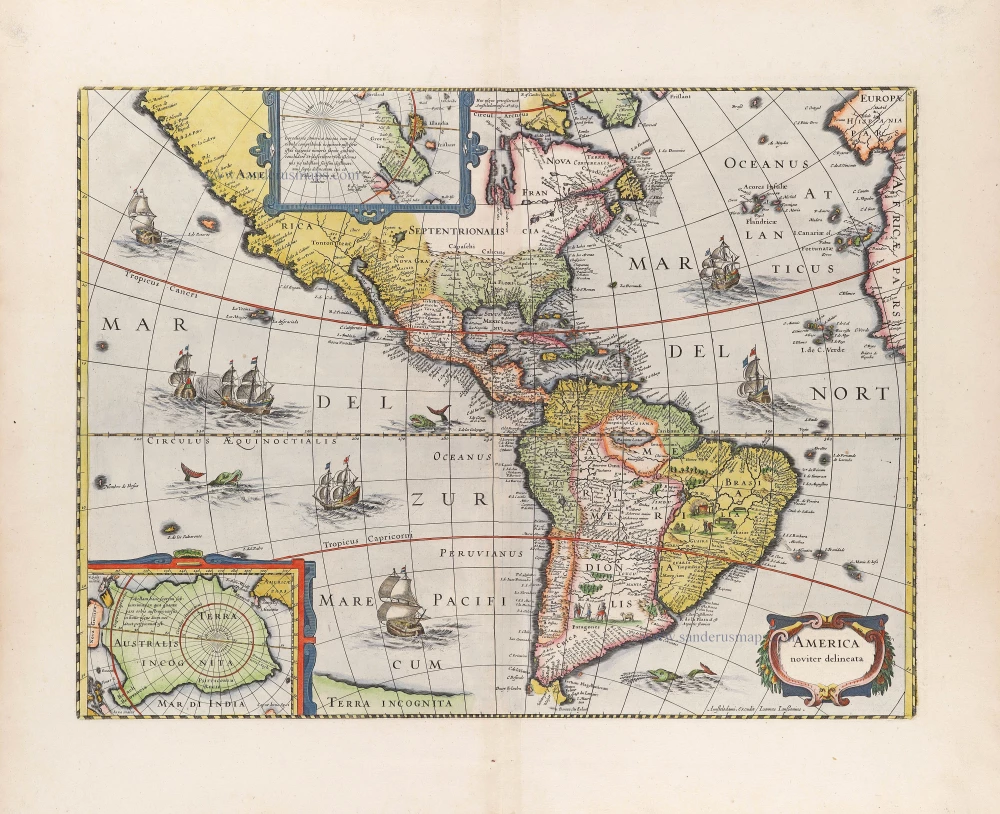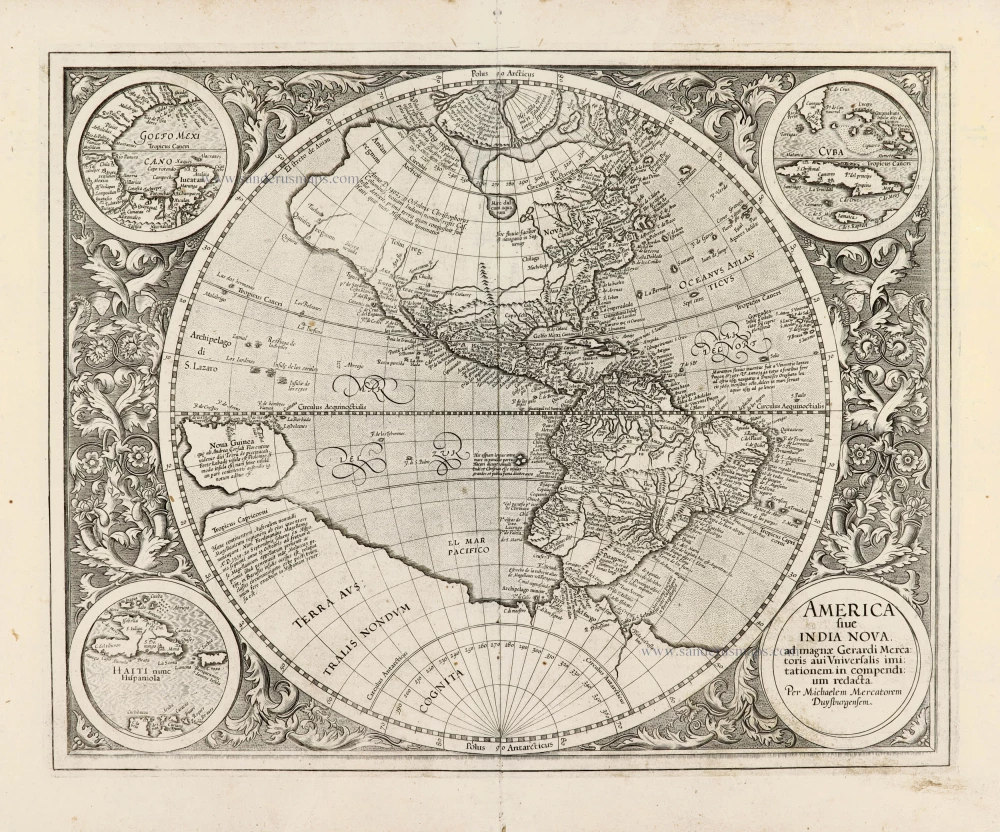America by Sebastian Münster. 1555
In 1540, Sebastian Munster, who was to become one of the most influential cartographers in the sixteenth century, published his edition of Ptolemy's Geography with a further section of modern, more up-to-date maps. He included a set of continental maps for the first time; the America was the earliest of any note. The map's inclusion in Münsters Cosmography, first published in 1544, sealed the fate of "America" as the name for the New World. The Portuguese flag is shown flying over the South Atlantic, and the Spanish one over her possessions in the Caribbean. The Strait of Magellan is named again, and Mare Pacificum appears for the first time on a printed map. Magellan's ship Victoria, the only survivor of five vessels, appears in the middle of this ocean. Marco Polo's influence can be seen with Zipangri (Japan), appearing three years before the earliest known contact with Europeans and his Archipelagus 7448 insularu. The Yucatan is still shown as an island, and the lake at Temistitan is depicted emptying into the Gulf of Mexico. North America is not shown as accurately as the southern half of the continent; it has largely been neglected so far by explorers. When Giovanni di Verrazzano, in the service of Francis I of France, passed by the Outer Banks of the Carolinas in 1524, he mistook Pamlico and Albemarle Sounds for the 'Oriental Sea' that led to Cathay and the rich Spice Islands. Here, Münster perpetuates this error and, through the success of this book, provides a considerable impetus to the exploration of the region. The only placenames occurring here are C.Britonum, marking England's early explorations, Corterati, probably Newfoundland after the Corte Reals, and Terra Florida. FRANCISCA is named in honour of Francis I. (Burden) Münster produced sixty-one double-page maps for use in various editions of Ptolemy's Geographia and his own Cosmographia. Some of these maps appeared in all editions of both works, some only in specific editions. All were woodcut maps with the title supplied in letterpress in the upper margin; these titles varied from edition to edition.
Sebastian Münster (1488-1552)
Sebastian Münster, a German geographer, cartographer, Hebraist, and theologian, was born in Ingelheim, near Mainz In 1505, he went to Heidelberg to enter the Franciscan order. In 1507 he went to Louvain, where he studied mathematics, geography, and astronomy. In 1509 Münster became a student of Konrad Pelikan, who taught Hebrew and Greek as well as mathematics and cosmography. In 1518 he completed his studies at the University of Tübingen. He was the favorite of the famous mathematician and astronomer Johann Stöffler.
In 1524 Münster was appointed professor of Hebrew at Heidelberg University. In 1525 he published his first map as part of a broadside: The Instrument of the Suns combined a map, calendar, astrological almanac, sundial, and nocturnal on one attractive sheet, suitable for wall mounting.
In 1540 he published a Latin edition of Ptolemy's Geographia with illustrations. He based this edition on the Latin translation by Willibald Pirkheimer and produced new maps to supplement the Ptolemaic maps. The twenty-seven maps of the Ptolemaic canon are supplemented by twenty-one new maps. Further editions appeared in 1541 and 1542.
In 1544 he published the Cosmographia, a bulky book with 659 pages and some 520 woodcuts. Maps in this edition included three maps from the Ptolemaic canon and fourteen modern maps (from previous editions of the Geographia), as well as nine new maps. Later editions (1545, 1546, 1548) enlarged the Cosmographia. The 1550 edition contains cities, portraits, and costumes. These editions in both Latin and German constitute the full fruition of Münster's dream of a comprehensive geography.
The Cosmographia was one of the most successful works of the 16th century. It passed through 24 editions in 100 years, in different languages, including Latin, French, Italian, English, and even Czech. The last German edition was published in 1628.
He died at Basel of the plague in 1552.
As a cartographer, Münster deserves special recognition for formulating a plan for a comprehensive and uniform map of a country. As a geographer, his greatest achievement was the Cosmographia. (Karrow).
Le table des neufues lesquelles on appelle isles d'Occident & d'Indie pour divers regard.
Item Number: 30379 Authenticity Guarantee
Category: Antique maps > America > The Americas
America by Sebastian Münster.
Title: Le table des neufues lesquelles on appelle isles d'Occident & d'Indie pour divers regard.
Date of the first edition: 1540.
Date of this map: 1555.
Woodcut, printed on paper.
Image size: 255 x 340mm (10.04 x 13.39 inches).
Sheet size: 305 x 385mm (12.01 x 15.16 inches).
Verso: French text.
Condition: Excellent.
Condition Rating: A+.
From: La Cosmographie Universelle, ... Basel, H. Petri, 1555. (First edition: 1544).
In 1540, Sebastian Munster, who was to become one of the most influential cartographers in the sixteenth century, published his edition of Ptolemy's Geography with a further section of modern, more up-to-date maps. He included a set of continental maps for the first time; the America was the earliest of any note. The map's inclusion in Münsters Cosmography, first published in 1544, sealed the fate of "America" as the name for the New World. The Portuguese flag is shown flying over the South Atlantic, and the Spanish one over her possessions in the Caribbean. The Strait of Magellan is named again, and Mare Pacificum appears for the first time on a printed map. Magellan's ship Victoria, the only survivor of five vessels, appears in the middle of this ocean. Marco Polo's influence can be seen with Zipangri (Japan), appearing three years before the earliest known contact with Europeans and his Archipelagus 7448 insularu. The Yucatan is still shown as an island, and the lake at Temistitan is depicted emptying into the Gulf of Mexico. North America is not shown as accurately as the southern half of the continent; it has largely been neglected so far by explorers. When Giovanni di Verrazzano, in the service of Francis I of France, passed by the Outer Banks of the Carolinas in 1524, he mistook Pamlico and Albemarle Sounds for the 'Oriental Sea' that led to Cathay and the rich Spice Islands. Here, Münster perpetuates this error and, through the success of this book, provides a considerable impetus to the exploration of the region. The only placenames occurring here are C.Britonum, marking England's early explorations, Corterati, probably Newfoundland after the Corte Reals, and Terra Florida. FRANCISCA is named in honour of Francis I. (Burden) Münster produced sixty-one double-page maps for use in various editions of Ptolemy's Geographia and his own Cosmographia. Some of these maps appeared in all editions of both works, some only in specific editions. All were woodcut maps with the title supplied in letterpress in the upper margin; these titles varied from edition to edition.
Sebastian Münster (1488-1552)
Sebastian Münster, a German geographer, cartographer, Hebraist, and theologian, was born in Ingelheim, near Mainz In 1505, he went to Heidelberg to enter the Franciscan order. In 1507 he went to Louvain, where he studied mathematics, geography, and astronomy. In 1509 Münster became a student of Konrad Pelikan, who taught Hebrew and Greek as well as mathematics and cosmography. In 1518 he completed his studies at the University of Tübingen. He was the favorite of the famous mathematician and astronomer Johann Stöffler.
In 1524 Münster was appointed professor of Hebrew at Heidelberg University. In 1525 he published his first map as part of a broadside: The Instrument of the Suns combined a map, calendar, astrological almanac, sundial, and nocturnal on one attractive sheet, suitable for wall mounting.
In 1540 he published a Latin edition of Ptolemy's Geographia with illustrations. He based this edition on the Latin translation by Willibald Pirkheimer and produced new maps to supplement the Ptolemaic maps. The twenty-seven maps of the Ptolemaic canon are supplemented by twenty-one new maps. Further editions appeared in 1541 and 1542.
In 1544 he published the Cosmographia, a bulky book with 659 pages and some 520 woodcuts. Maps in this edition included three maps from the Ptolemaic canon and fourteen modern maps (from previous editions of the Geographia), as well as nine new maps. Later editions (1545, 1546, 1548) enlarged the Cosmographia. The 1550 edition contains cities, portraits, and costumes. These editions in both Latin and German constitute the full fruition of Münster's dream of a comprehensive geography.
The Cosmographia was one of the most successful works of the 16th century. It passed through 24 editions in 100 years, in different languages, including Latin, French, Italian, English, and even Czech. The last German edition was published in 1628.
He died at Basel of the plague in 1552.
As a cartographer, Münster deserves special recognition for formulating a plan for a comprehensive and uniform map of a country. As a geographer, his greatest achievement was the Cosmographia. (Karrow).

